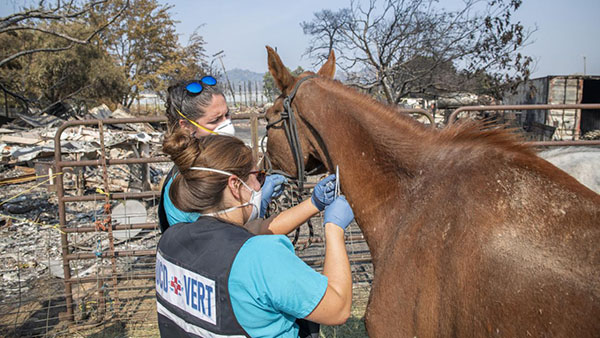Protecting Animals When Disaster Strikes- State of CA Creates New Veterinary Emergency Team

UC Davis Veterinary Emergency Response Team members help care for horse in the field during the LNU Lightning Complex fire. (UC Davis School of Veterinary Medicine)
UC Davis
By: Amy Quinton
University of California, Davis, leaders, veterinarians and California legislators unveiled a new emergency program to help rescue animals in disasters. Called the California Veterinary Emergency Team and administered by the UC Davis School of Veterinary Medicine, the program will support and train a network of government agencies, individuals and organizations to aid domestic animals and livestock during emergencies.
California is providing $3 million a year for the California Veterinary Emergency Team, under legislation authored by Sen. Steve Glazer and incorporated into the state budget recently signed by Gov. Gavin Newsom. The program will be modeled after the UC Davis-led Oiled Wildlife Care Network, created in 1994 to mobilize volunteers and professionals to rescue and treat shorebirds and other wildlife that are injured during oil spills.
“We want to create a robust, coordinated effort statewide to help animals during disasters,” said Michael Ziccardi, director of the Oiled Wildlife Care Network and executive director of the One Health Institute. “The California Veterinary Emergency Team will bring together state and county agencies and organizations charged with emergency response to help them organize, train and adopt best practices.”
Current need
A primary goal of the new California Veterinary Emergency Team is to increase response capacity and help standardize disaster response across counties, bringing together disparate and fragmented groups. Currently, the California Animal Response Emergency System, or CARES, within the California Department of Food and Agriculture is charged with managing evacuation and care of animals during emergencies. They also work with community animal response teams and nonprofit organizations.
“Recent wildfires have overwhelmed the state’s ability to safely evacuate and care for household animals and livestock,” Sen. Glazer said. “Twice in the past five years we have had to call on Texas to send an emergency team to assist. That puts not just animals at risk but also increases the danger for residents and first responders if people stay behind fire lines because they fear their animals will not be cared for. We need this new team to help train, coordinate and lead the hundreds of volunteers who are eager to help. Our goal is a team that is ready to respond anywhere in the state with a mobile command center, a clinic if necessary, and the veterinarians, equipment and medicine to get the job done.”
The California Veterinary Emergency Team would be available to mobilize response to disasters anywhere in California, operating under a memorandum of understanding with the California Department of Food and Agriculture and the Office of Emergency Services. Between disasters, the team would recruit, train and drill volunteers, conduct research, and train veterinarians and veterinary students on best practices in shelter and emergency medicine.
Leaders in the field
UC Davis has provided leadership in veterinary disaster response through its Veterinary Emergency Response Team, Wildlife Disaster Network partnership formed with the California Department of Fish and Wildlife, and its Veterinary Medical Teaching Hospital disaster patient care. UC Davis VERT and hospital teams typically triage, evaluate, treat and/or rescue more than 1,000 animals in the field in every fire. During the 2018 Camp Fire alone, the teams helped more than 1500 animals, including 70 that were brought in for treatment at the hospital.
“The funding of the California Veterinary Emergency Team provides unprecedented resources that will bring multiple partners across the state of California together to enhance recruitment, coordination, and training of volunteers, veterinarians and veterinary students in best practices in disaster response and sheltering of animals in disasters,” said Michael Lairmore, former dean and distinguished professor at the School of Veterinary Medicine.
Lairmore said the university is committed to working with partners across the state to ensure that the California Veterinary Emergency Team program is successful. Developing the California Veterinary Emergency Team is expected to take some time. It’s anticipated the program will be in an organizational phase during this fire season.










